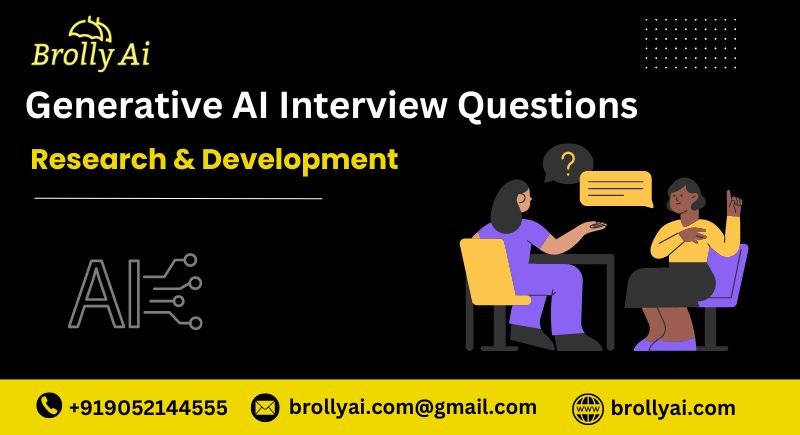Generative AI Interview Questions
Generative AI Interview Questions[Fundamentals ]

1. What is the difference between supervised, unsupervised, and reinforcement learning?
Answer: Supervised learning involves training a model on labeled data, where the correct output is known. Unsupervised learning involves finding patterns or structures in data without predefined labels. Reinforcement learning involves training an agent to make a sequence of decisions by rewarding or penalizing it based on the actions it takes.
2. Explain the concept of overfitting and how it can be prevented?
Answer: Overfitting occurs when a model learns the training data too well, including noise and outliers, which negatively impacts its performance on new, unseen data. It can be prevented using techniques such as cross-validation, regularization (L1, L2), dropout, and simplifying the model.
3. What are the common activation functions used in neural networks?
Answer: Common activation functions include Sigmoid, Tanh, ReLU (Rectified Linear Unit), Leaky ReLU, and Softmax.
4. Describe the backpropagation algorithm.
Answer: Backpropagation is an algorithm used to train neural networks by minimizing the error between predicted and actual outputs. It involves a forward pass to compute the output and a backward pass to compute gradients of the loss function with respect to each weight, which are then used to update the weights using gradient descent.
5.What is gradient descent, and what are its variants?
Answer: Gradient descent is an optimization algorithm used to minimize the loss function by iteratively updating the model’s parameters in the direction of the negative gradient. Variants include Stochastic Gradient Descent (SGD), Mini-batch Gradient Descent, and optimizers like Adam, RMSprop, and Adagrad.
6.How does the bias-variance trade-off affect model performance?
Answer: The bias-variance trade-off describes the balance between underfitting and overfitting. High bias (underfitting) occurs when a model is too simple, missing patterns in the data. High variance (overfitting) occurs when a model is too complex, capturing noise in the data. The goal is to find a model with low bias and low variance for optimal performance.
7.What are Generative Adversarial Networks (GANs)?
Answer: GANs are a class of generative models consisting of two neural networks, a generator and a discriminator, that are trained simultaneously. The generator creates fake data, while the discriminator tries to distinguish between real and fake data. The goal is for the generator to produce data indistinguishable from real data.
8.Explain the architecture and working of a Variational Autoencoder (VAE).
Answer: A VAE consists of an encoder and a decoder. The encoder maps input data to a latent space, representing the data as a distribution. The decoder reconstructs the data from this distribution. The VAE is trained to maximize the likelihood of the data while ensuring the latent space follows a Gaussian distribution, enabling smooth interpolations and new data generation.
9.How do GANs differ from VAEs?
Answer: GANs generate data by learning to fool a discriminator, creating high-quality samples but with less control over the latent space. VAEs generate data by learning a structured latent space, allowing for controlled data generation and interpolations but often producing blurrier samples compared to GANs.
10.What are the key components of a GAN?
Answer: The key components of a GAN are the generator, which creates fake data, and the discriminator, which evaluates the authenticity of the data. Both components are neural networks that are trained simultaneously in a minimax game.
11.Describe the role of the generator and discriminator in a GAN.
Answer: The generator creates synthetic data from random noise, aiming to produce outputs that resemble real data. The discriminator evaluates the data, distinguishing between real and synthetic samples. The generator aims to improve until the discriminator cannot reliably tell the difference between real and fake data.
12.How does a Transformer architecture work?
Answer: A Transformer architecture uses self-attention mechanisms to process sequences of data in parallel, capturing long-range dependencies and relationships within the data. It consists of an encoder and a decoder, where the encoder processes the input sequence and the decoder generates the output sequence.
13.What are the benefits of using Transformers in generative models?
Answer: Transformers can handle long-range dependencies, parallelize processing for faster training, and achieve state-of-the-art performance in tasks such as natural language processing, image generation, and more. They also provide flexibility in handling various input and output lengths.
14.Explain the concept of latent space in generative models.
Answer: Latent space is a compressed, abstract representation of input data learned by generative models. It captures the underlying features and structure of the data, allowing for efficient data generation, interpolation, and manipulation within this reduced-dimensional space.
15.How does the concept of “conditioning” work in Conditional GANs?
Answer: In Conditional GANs (cGANs), both the generator and discriminator receive additional information (e.g., class labels or attributes) as input, allowing the generator to produce data conditioned on this information. This enables controlled generation of data with specific characteristics.
16.Describe the architecture of a Sequence-to-Sequence (Seq2Seq) model.
Answer: A Seq2Seq model consists of an encoder-decoder architecture, where the encoder processes the input sequence into a context vector (latent representation), and the decoder generates the output sequence from this context vector. It is commonly used in tasks like machine translation and text summarization
17.Which deep learning frameworks are you familiar with?
Answer: Common frameworks include TensorFlow, PyTorch, Keras, and MXNet. Each framework offers various tools and functionalities for building and training neural networks.
18.Compare TensorFlow and PyTorch.
Answer: TensorFlow is known for its robust production capabilities, extensive ecosystem, and support for deployment on various platforms. PyTorch is praised for its dynamic computation graph, ease of use, and strong community support, making it popular for research and prototyping.
19.How do you implement a simple GAN in TensorFlow/PyTorch?
Answer: In TensorFlow/PyTorch, implementing a GAN involves defining the generator and discriminator networks, the loss functions for both networks, and the training loop where the generator and discriminator are alternately trained using backpropagation.
20.Explain the process of model saving and loading in your preferred framework.
Answer: In TensorFlow, models can be saved using model.save() and loaded with tf.keras.models.load_model(). In PyTorch, models are saved with torch.save(model.state_dict()) and loaded with model.load_state_dict(torch.load()).
21.What are the common challenges in training models with large datasets?
Answer: Common challenges include managing computational resources, handling data preprocessing and augmentation efficiently, ensuring data is balanced and representative, and dealing with long training times and potential overfitting.
Generative AI Interview Questions [Technical]

1.How do you approach data preprocessing for training generative models?
Answer: Data preprocessing involves normalizing or standardizing data, handling missing values, augmenting data to increase diversity, and ensuring the data is properly formatted and split into training, validation, and test sets.
2. Can you give an example of how you managed imbalanced datasets in a previous project?
Answer: One approach is using techniques like oversampling the minority class, undersampling the majority class, generating synthetic samples using methods like SMOTE, and applying class weighting during training to balance the influence of each class.
3.What techniques do you use to handle missing data?
Answer: Techniques include imputation (mean, median, mode, or using predictive models), dropping rows or columns with excessive missing values, and using algorithms that can handle missing data natively.
4. How do you ensure data quality and integrity before training a model?
Answer: Ensuring data quality involves checking for and correcting errors, validating data consistency, removing duplicates, handling outliers, and ensuring the data is representative of the problem domain.
5.What techniques do you use to prevent overfitting in generative models?
Answer: Techniques include using dropout, early stopping, regularization (L1, L2), data augmentation, simplifying the model architecture, and employing cross-validation.
6. How do you evaluate the performance of a generative model?
Answer: Performance can be evaluated using metrics such as Inception Score (IS), Fréchet Inception Distance (FID), visual inspection, reconstruction error (for VAEs), and domain-specific metrics depending on the application.
7.What is the role of the loss function in training generative models?
Answer: The loss function measures the difference between the generated data and the real data (or the target output). It guides the optimization process by providing a gradient to update the model’s parameters, helping the model learn to generate more accurate or realistic data.
8. Describe a situation where you had to fine-tune a pre-trained model for a specific task.
Answer: Fine-tuning involves taking a pre-trained model (e.g., a GAN trained on a large dataset) and further training it on a smaller, task-specific dataset to adapt it to new data while leveraging the knowledge already learned.
10.How do you handle hyperparameter tuning in your models?
Answer: Hyperparameter tuning can be done using grid search, random search, Bayesian optimization, or automated tools like Hyperopt and Optuna to find the best combination of hyperparameters for optimal model performance.
11. What are some common pitfalls in training GANs, and how do you address them?
Answer: Common pitfalls include mode collapse (generator produces limited diversity), vanishing gradients, and instability during training. These can be addressed using techniques like feature matching, using different architectures (e.g., Wasserstein GAN), and careful tuning of hyperparameters.
12.Explain the concept of transfer learning and its advantages.
Answer: Transfer learning involves using a pre-trained model on a new but related task. It leverages the knowledge learned from the pre-trained model, reducing the need for large datasets and extensive training, and often improving performance and convergence speed.
13.How do you handle the challenge of long training times for deep learning models?
Answer: Techniques include using hardware acceleration (GPUs, TPUs), parallel processing, distributed training, using mixed precision training, optimizing data pipelines, and saving checkpoints to resume training without starting from scratch.
14.Describe a project where you applied generative AI to solve a real-world problem. What was the impact?
Answer: For example, applying a GAN to generate synthetic medical images to augment a small dataset, improving the performance of a diagnostic model. The impact was better model accuracy and robustness due to increased data diversity.
15. How would you apply generative AI to improve a specific business process or product feature?
Answer: Generative AI can be used to create realistic product prototypes, enhance customer experience through personalized content generation, automate design processes, generate synthetic training data, and improve creative processes in fields like advertising and entertainment.
16.What considerations are important when deploying generative models in production?
Answer: Considerations include ensuring model robustness, handling latency and scalability, monitoring model performance, implementing mechanisms for retraining and updating the model, addressing ethical concerns, and ensuring compliance with data privacy regulations.
17. How do you handle the ethical implications of generative AI, such as deepfakes?
Answer: Addressing ethical implications involves implementing detection mechanisms, ensuring transparency and accountability, using generative models responsibly, adhering to guidelines and regulations, and promoting awareness about potential misuse and its consequences.
18.Describe a situation where you had to debug a failing generative model. What steps did you take?
Answer: Debugging involves checking the data pipeline, verifying model architecture and parameters, monitoring loss curves for signs of instability, validating training and validation processes, and systematically isolating and addressing issues through experiments and adjustments.
19. How do you approach the challenge of model interpretability in generative AI?
Answer: Approaches include using visualization techniques to understand latent space, analyzing feature importance, employing explainable AI tools, and validating model outputs through qualitative and quantitative assessments.
20.What is the importance of using a validation set during model training?
Answer: A validation set helps monitor the model’s performance on unseen data, guiding hyperparameter tuning, preventing overfitting, and providing an unbiased evaluation of the model’s generalization capability.
21.How do you ensure reproducibility in your generative AI experiments?
Answer: Ensuring reproducibility involves setting random seeds, documenting experiments thoroughly, using version control for code and data, maintaining consistent environments, and sharing code and models publicly when possible.
22.What role do ensemble methods play in generative AI, if any?
Answer: While less common in generative AI, ensemble methods can improve robustness and diversity in generated outputs by combining multiple generative models, leveraging their complementary strengths to produce higher-quality results.
23.How do you balance computational efficiency with model accuracy in generative AI?
Answer: Balancing efficiency and accuracy involves optimizing model architectures, using techniques like model pruning and quantization, employing efficient training strategies, and leveraging advanced hardware and parallel computing resources.
24.What are some ways to improve the diversity of outputs from a generative model?
Answer: Techniques include using diverse training data, incorporating noise and randomness in the generation process, using regularization methods, employing models designed to promote diversity (e.g., InfoGAN), and monitoring for mode collapse.
25. How do you approach model deployment for applications with real-time constraints?
Answer: Approaches include optimizing model inference speed, using model quantization and pruning, deploying on edge devices or specialized hardware (e.g., GPUs, TPUs), and implementing efficient data handling and processing pipelines
GENERATIVE AI INTERVIEW QUESTIONS [Research & Development]

1. Can you discuss a recent research paper on generative AI that you found interesting? How would you apply the findings to a practical project?
Answer: For example, a paper on StyleGAN can be applied to create realistic avatars for virtual environments by leveraging the model’s ability to generate high-quality, diverse images with controllable features.
2. What are the latest advancements in generative AI, and how do you stay updated with developments in this field?
Answer: Recent advancements include improvements in GAN architectures, applications of Transformers in image and text generation, diffusion models, and advances in unsupervised and semi-supervised learning. Staying updated involves reading research papers, attending conferences, participating in online courses, and engaging with the AI community.
3.How would you contribute to advancing the field of generative AI in your role?
Answer: Contributions can include conducting original research, developing novel architectures and techniques, collaborating with academic and industry partners, publishing findings, and applying cutting-edge methods to solve real-world problems.
3.Describe a novel generative AI approach you would like to explore or develop?
Answer: One approach could be integrating reinforcement learning with generative models to create more intelligent and adaptive agents capable of generating contextually relevant content in dynamic environments.
4.What challenges do you foresee in scaling generative AI models for broader applications?
Answer: Challenges include computational demands, ensuring model robustness and reliability, addressing ethical and legal concerns, managing data privacy, and ensuring accessibility and usability for diverse users and applications.
5.What ethical considerations are important when developing and deploying generative AI models?
Answer: Considerations include ensuring transparency, avoiding bias and discrimination, preventing misuse (e.g., deepfakes), protecting data privacy, and promoting responsible and fair use of generative technologies.
6.How do you address bias in generative AI models?
Answer: Addressing bias involves using diverse and representative training data, employing fairness-aware algorithms, conducting regular audits, and implementing bias mitigation techniques during training and evaluation.
7.What are the potential societal impacts of generative AI, both positive and negative?
Answer: Positive impacts include advancements in healthcare, creative industries, and automation. Negative impacts include the potential for misuse in creating fake content, reinforcing biases, and ethical dilemmas related to job displacement and privacy.
8.How do you ensure transparency and accountability in your generative AI projects?
Answer: Ensuring transparency involves documenting the development process, providing clear explanations of model behavior, using explainable AI tools, and being accountable for the ethical implications of the technology.
9.What strategies do you use to prevent the misuse of generative AI technologies?
Answer: Strategies include implementing safeguards and detection mechanisms, promoting ethical guidelines, collaborating with stakeholders to establish standards, and educating users and the public about potential risks and responsible use.
10.How would you approach the challenge of generating synthetic data while preserving privacy?
Answer: Approaches include using differential privacy techniques, generating synthetic data that does not reveal sensitive information, employing privacy-preserving machine learning methods, and validating that the synthetic data meets privacy standards.
11.What role do regulations and policies play in the development and deployment of generative AI?
Answer: Regulations and policies help ensure ethical use, protect data privacy, prevent misuse, and promote transparency and accountability. They provide guidelines for developers and organizations to follow, fostering responsible innovation and trust in AI technologies.
12.How do you handle the potential legal implications of using generative AI in your projects?
Answer: Handling legal implications involves understanding relevant laws and regulations, consulting with legal experts, ensuring compliance with data protection and intellectual property laws, and addressing any potential risks proactively.
13.What measures do you take to ensure the security of generative AI models and data?
Answer: Measures include implementing robust data security practices, encrypting sensitive information, regularly updating and patching systems, conducting security audits, and ensuring secure deployment and access controls.
14.How do you promote ethical AI practices within your team or organization?
Answer: Promoting ethical practices involves fostering a culture of responsibility, providing training and resources, establishing clear guidelines and policies, encouraging open discussions about ethical dilemmas, and leading by example.
15.Describe a time when you had to explain a complex generative AI concept to a non-technical stakeholder?
Answer: Effective communication involves simplifying the concept, using analogies, visual aids, and focusing on the impact and relevance to the stakeholder’s concerns, ensuring they understand the benefits and limitations of the technology.
16.How do you collaborate with cross-functional teams in generative AI projects?
Answer: Collaboration involves clear communication, setting shared goals, leveraging diverse expertise, using collaborative tools, and regularly updating team members on progress and challenges, ensuring alignment and effective problem-solving.
17.What strategies do you use to document your work in generative AI projects?
Answer: Documentation strategies include maintaining comprehensive code comments, creating detailed project reports, using version control systems, writing clear and concise documentation for models and methodologies, and sharing knowledge through internal and external platforms.
18.How do you handle feedback and criticism on your generative AI work?
Answer: Handling feedback involves actively listening, being open to constructive criticism, considering different perspectives, using feedback to improve and refine the work, and maintaining a collaborative and growth-oriented mindset.
19.What role does collaboration with academic and industry partners play in your generative AI projects?
Answer: Collaboration provides access to cutting-edge research, diverse expertise, and resources, fostering innovation and accelerating progress. It enables knowledge sharing, joint problem-solving, and the development of impactful solutions.
20.How do you ensure effective communication of your research findings or project outcomes?
Answer: Effective communication involves tailoring the message to the audience, using clear and concise language, providing visual aids, publishing in reputable journals or conferences, and engaging with the community through presentations and discussions.
21.Describe a time when you successfully led a team in a generative AI project.
Answer: Successful leadership involves setting clear goals, providing direction and support, fostering collaboration, resolving conflicts, and ensuring the team stays motivated and focused, leading to the successful completion of the project.
22.What methods do you use to stay organized and manage time effectively in your projects?
Answer: Methods include setting priorities, creating detailed project plans, using project management tools, breaking tasks into manageable chunks, setting deadlines, and regularly reviewing progress to stay on track.
23.How do you approach interdisciplinary research in generative AI?
Answer: Approaching interdisciplinary research involves collaborating with experts from different fields, integrating diverse perspectives, leveraging cross-disciplinary methodologies, and focusing on common goals to address complex problems.
24.What are the key considerations when presenting generative AI research to a broader audience?
Answer: Key considerations include simplifying technical jargon, highlighting the relevance and impact, using engaging visuals, providing real-world examples, and addressing potential concerns and implications.
25.What future trends do you see emerging in generative AI, and how do you plan to stay ahead?
Answer: Emerging trends include advancements in multimodal generative models, ethical AI, and integration with other technologies like reinforcement learning and quantum computing. Staying ahead involves continuous learning, attending conferences, participating in research communities, and experimenting with new ideas.
26.How would you leverage generative AI to address global challenges?
Answer: Leveraging generative AI can address global challenges by creating innovative solutions in healthcare (e.g., drug discovery), climate change (e.g., energy-efficient designs), education (e.g., personalized learning), and more, contributing to sustainable development and societal well-being.
27.What are the potential risks and benefits of increasingly autonomous generative AI systems?
Answer: Benefits include increased efficiency, creativity, and problem-solving capabilities. Risks involve ethical concerns, loss of control, potential misuse, and unintended consequences. Balancing these requires careful design, regulation, and ongoing monitoring.
28.Describe a visionary project you would like to pursue using generative AI.
Answer: A visionary project could involve creating an intelligent, generative virtual assistant capable of understanding and generating human-like responses across multiple languages and domains, revolutionizing human-computer interaction and accessibility.
29.How do you see the role of generative AI evolving in the next decade?
Answer: Generative AI will likely become more integrated into everyday applications, enhancing creativity, automation, and personalization. It will drive advancements in various fields, from entertainment to medicine, while ethical considerations will shape its responsible development and use.
30.What are the biggest challenges in advancing generative AI, and how would you address them?
Answer: Challenges include ethical concerns, data privacy, computational demands, and ensuring robustness and reliability. Addressing them involves interdisciplinary collaboration, investing in research, developing ethical guidelines, and promoting transparency and accountability.
31.How can generative AI be used to enhance human creativity and innovation?
Answer: Generative AI can augment human creativity by providing new ideas, designs, and solutions, automating repetitive tasks, enabling rapid prototyping, and offering personalized recommendations, fostering a collaborative environment where humans and AI co-create.
32.What impact do you think generative AI will have on the job market and workforce?
Answer: Generative AI may automate certain tasks, leading to job displacement in some areas, while creating new opportunities in AI development, maintenance, and creative industries. Preparing the workforce through education and reskilling will be crucial to adapting to these changes.
33.How do you envision the integration of generative AI with other emerging technologies?
Answer: Integration with technologies like IoT, blockchain, and quantum computing will enhance the capabilities of generative AI, enabling more secure, efficient, and powerful applications across various domains, driving innovation and transformation.
34.What strategies would you propose for fostering public trust in generative AI?
Answer: Strategies include promoting transparency, ensuring ethical use, involving diverse stakeholders in decision-making, educating the public about benefits and risks, and demonstrating tangible positive impacts on society.
35.How do you ensure that generative AI solutions are accessible to diverse populations?
Answer: Ensuring accessibility involves designing inclusive models, considering diverse linguistic and cultural contexts, providing affordable and user-friendly tools, and collaborating with communities to address specific needs and challenges.
36.What role do you see for generative AI in personalized medicine?
Answer: Generative AI can contribute to personalized medicine by generating patient-specific treatment plans, predicting disease outcomes, designing custom drugs, and enhancing medical imaging, leading to more effective and tailored healthcare solutions.
37.How can generative AI be leveraged to improve environmental sustainability?
Answer: Generative AI can optimize resource usage, design energy-efficient systems, model and predict environmental changes, and generate innovative solutions for renewable energy, waste reduction, and conservation efforts, promoting sustainability.
37.What are the key considerations for scaling generative AI solutions globally?
Answer: Key considerations include addressing diverse data sources and contexts, ensuring ethical and fair use, managing computational and infrastructure requirements, navigating regulatory landscapes, and fostering international collaboration.
38.How would you address the challenge of ensuring data privacy in large-scale generative AI deployments?
Answer: Addressing data privacy involves implementing robust encryption, using federated learning, adhering to data protection regulations, conducting regular audits, and developing privacy-preserving techniques to safeguard sensitive information.
39.What are the potential applications of generative AI in creative industries like art and music?
Answer: Applications include generating original artwork, composing music, creating virtual characters and environments, enhancing creative workflows, and providing tools for artists and musicians to explore new styles and ideas, expanding the boundaries of creativity.
40.How do you see generative AI contributing to advancements in scientific research?
Answer: Generative AI can accelerate scientific research by generating hypotheses, simulating complex systems, optimizing experimental designs, discovering new materials and drugs, and providing insights from large datasets, driving innovation and discovery.
41.What are the ethical considerations for using generative AI in sensitive domains like healthcare and finance?
Answer: Ethical considerations include ensuring fairness and non-discrimination, maintaining patient and customer confidentiality, providing transparency in decision-making, addressing biases, and ensuring accountability and trustworthiness in AI systems.
42.How would you promote interdisciplinary collaboration to advance generative AI research and applications?
Answer: Promoting collaboration involves fostering open communication, creating interdisciplinary research teams, organizing joint workshops and conferences, sharing resources and knowledge, and encouraging a culture of mutual respect and learning.
43.What are the long-term implications of generative AI for human-AI interaction?
Answer: Long-term implications include more seamless and intuitive interactions, enhanced collaboration and co-creation, new forms of communication and expression, ethical and social considerations, and the need for ongoing adaptation and learning as AI becomes more integrated into daily life.
Upgrading Software Engineers to Generative AI Engineers Brolly AI is your trusted partner for top-quality training courses. Our commitment to excellence ensures that you receive the most comprehensive and up-to-date education in your chosen field. With a focus on practical skills and industry relevance, our courses are designed to empower you with the knowledge and expertise needed to succeed. Join Brolly AI for a trans-formative learning experience that propels your career to new heights. Quality training, tailored for your success

